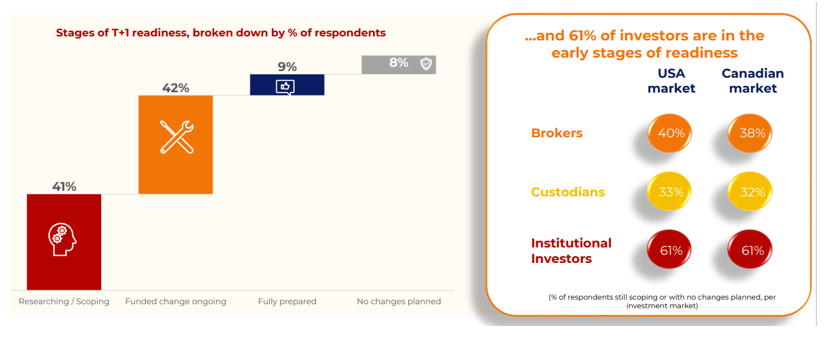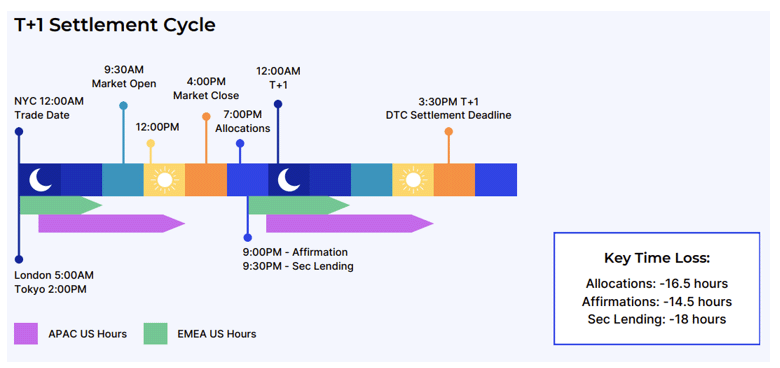
During a particularly active period of securities market rulemakings, financial industry reactions to new regulatory proposals often boil down to “too much, too soon.” The U.S. Securities and Exchange Commission’s shortening of the broker-dealer transaction settlement cycle from two days to one day after the trade date (T+2 to T+1) is no exception.
In its final rule of February 2023, the SEC set an implementation date of May 28, 2024, making only a partial concession to some market participants’ pleas for additional months of preparation time. Agency Chair Gary Gensler hailed the benefits of less latency, lower risk and greater liquidity, all contributing to overriding goals of making “our market plumbing more resilient, timely, orderly and efficient.”
Ever since the last such conversion, from T+3 to T+2, in 2017, T+1 was regarded as the logical next step. (Taking a longer view, some observers now say same-day, or T+0, settlement may be feasible, perhaps facilitated by blockchain technology.)
But as the T+1 deadline came into focus early this year, many industry players were not up to speed.
According to Operationalizing T+1, published in March, “41% of the market” had not begun planning for the changeover; 9% was said to be fully prepared. The findings are from a global survey sponsored by the Depository Trust & Clearing Corp. (DTCC) and Canadian Depository for Securities (CDS), with support from the Association for Financial Markets in Europe, Canadian Capital Markets Association and ISITC.
While North American brokers, custodians and institutional investors were furthest along – the U.S., Canada and Mexico are on the same timetable – the global scope of the challenge is indicated by the fact that “over 50% of European and Asia-Pacific market participants have not defined their plans to manage critical areas such as foreign exchange and securities lending,” said the DTCC-CDS summary.

Source: DTCC
“Challenges are especially felt by the buy side, with 61% of firms unprepared for the transition, primarily across mid-tier and boutique organizations,” the report said, adding, “In anticipation of the operational impact of T+1, 23% of investors are moving to centralized SSIs [standing settlement instructions] and trade matching to alleviate future service provider challenges.”
With “profound implications” across U.S. and global markets, T+1 could cost investors as much as $31 billion annually, Bloomberg Intelligence has said.
Affirmation Required
For T+1 completion, the DTCC, the principal U.S. post-trade infrastructure, recommends affirmation of trades by 9 p.m. on the trade date. In a March 25 statement, DTCC said the 9 p.m. affirmation rate at the end of February was 74.5%, up from 73% a month earlier. Prime brokers improved to 83% from 81%, but investment manager auto affirmations (central matching) fell three percentage points, to 89%. DTCC sees that rate “normalizing” above 92% as managers onboard to its Institutional Trade Processing and configure their brokers ahead of T+1.
While traders in the U.S. will still have the next day to meet the T+1 settlement deadline, those in other time zones will be more time-constrained.

Source: Clear Street, Citi
In a December note to investor clients, Brown Brothers Harriman described Japan’s unique market for passing information to settle trades, which now must be done a day sooner and will require greater automation.
Investors in continental Europe and the U.K. trading U.S. securities and settling through DTCC will have to hit 3 p.m. and 4 p.m. affirmation targets in the respective time zones.
“An Element of Short-Term Risk”
For all the risk-mitigating potential, “paradoxically, the impending transition to T+1 has introduced an element of short-term risk to the market,” says a report by prime brokerage and capital markets infrastructure provider Clear Street. “With the SEC enforcing a shorter settlement cycle, industry participants must ensure their technology and internal operations – and those of their clients and counterparties – can accommodate the change.
“Both the buy and sell sides should prepare to combat vulnerabilities, including legacy technology and settlement delays. In the short term, mitigating these risks will rely heavily on people-based solutions. Long-term solutions require systemic technology upgrades at all stages of the settlement cycle.”

Key 2024 transition dates (source: Clear Street).
Among available assistance from vendors, SS&C Technologies offers a T+1 readiness scorecard; collaboration platform Symphony Communication Services advises aggregating communication methods, leveraging a “trusted industry ops directory,” and interoperability across tech solutions; and S&P Global Market Intelligence is linking its Onboarding Accelerator with DTCC's ALERT service, enabling users to query the status of SSI reference data for a particular account and market directly within that S&P platform.
“Market participants must ramp up their preparations and testing,” said DTCC’s March statement. “At the same time, we encourage continued collaboration between investment managers and their custodians. By optimizing settlement workflows and embracing automation in the post-trade affirmation process, market participants will be better positioned to achieve T+1.”
The SEC’s Division of Examinations underscored in a March 27 Risk Alert the need to “understand the impacts of T+1 and the final rules to identify necessary changes and critical dependencies in order to successfully manage this transition.”
Leaders and Laggards
Broker-dealers and custodians globally are furthest ahead in the T+1 race, unsurprisingly given they are directly involved in DTCC testing.
Val Wotton, DTCC’s general manager of Institutional Trade Processing, said that those furthest behind are most likely regional investment firms that don’t interact directly with the DTCC and lack the resources of asset managers with global footprints.
DTCC’s Val Wotton
“It comes down to what conversations regional firms have had with their custodians, who they have historically relied on to manage affirmations, and whether they’ll continue to leverage their custodians or instead become self-affirming,” Wotton said.
Firms with operations worldwide can adopt a “follow the sun” strategy, leveraging staff in different time zones to meet tighter T+1 deadlines.
In the U.S., “we’ve seen firms shifting staff to the West Coast to gain three hours, and we’ve seen firms start up a second shift or tell people to shift their hours to work later,” said Deloitte principal Robert Walley. There are concerns, he added, such as the readiness of trades that settle bilaterally rather than through DTCC, and firms’ ability to deal with operational complications such as systems disruptions.
“A 24-hour recovery window will not work in a T+1 world,” Walley asserted. “A system outage or a missed file with 1,000 trades will be difficult to recover from before the allocation and affirmation deadlines.”
Cost Exposures
There is no explicit penalty for missing the affirmation deadline, or even T+1 settlement, but there would be consequences. Raghu Krishnamoorthy, practice head, securities and capital markets, at Wipro Technologies, said firms that are unable to align their operational processes will suffer settlement fails.
“That can have counterproductive effects of increased operational risk, and consequently increased margin requirements, which can in turn limit liquidity available for investment purposes,” Krishnamoorthy explained.
Deloitte’s Robert Walley
Costs could increase in other ways. Today, an executing broker will absorb the cost of settlement failures. In a T+1 world, those costs will likely be passed back to clients that continually miss settlement windows. With SEC examiners on their case, Walley anticipates firms will be up to snuff within a few months, without any major market upsets.
“But it may be creaky in different regions and among different market participants,” the Deloitte consultant said.
Shorter Cycles in Asia
Longtime capital markets executive Patrick L. Young, publisher of the Exchange Invest newsletter, pointed out in an article on the Vermiculus Financial Technology website that “sub-T+2 settlement has already been achieved. Kazakhstan and Russia achieved a remarkably frictionless T+0 with dematerialized tech-driven settlement up to a decade before US/EU went from T+3 to T+2.
“However, internationalization stopped that process as they had to walk back to T+2 to settle stock overseas through foreign CSDs [central securities depositories] like Clearstream, DTCC and Euroclear. With sanctions reducing the constraints of dealing with western foreign investors, MOEX in Moscow moved to T+1 settlement at the end of July 2023.”
India has achieved T+1 settlement across two CSDs, Young noted. In fact, India is teed up for T+0 this year and is already doing that selectively. The China Connect link between Hong Kong and the mainland is on a same-day timetable. Walley attributed these attainments to those markets’ being more self-contained and less globally connected and complex than the western ecosystems.
Young also wrote that going from T+2 to T+1 “may actually exacerbate the risk of settlement failures, at least in the short term, until the entire ecosystem becomes more automated and seamlessly integrated.” Because “big problems often arise post-trade and after the market close . . . central counterparty clearing will remain a vital tool because the settlement window is shorter.”
U.K. Recommendation and ESMA Feedback
European markets are contemplating T+1. The European Securities and Markets Authority (ESMA) opened a comment period last October, ahead of a report due to the European Commission in January 2025. The U.K. Accelerated Settlement Taskforce released recommendations on March 28 for moving to T+1 no later than 2027 and exploring coordination with other European jurisdictions.
An Investment Company Institute and ICI Global letter to ESMA encouraged T+1 “to minimize duration of settlement misalignment among major markets.”
The Association for Financial Markets in Europe cautioned that while the North American migration may provide useful lessons, “it is important to remember that the complexity of the European post-trade ecosystem could make T+1 adoption a more challenging project” than in other jurisdictions.
In a feedback statement published on March 21, considering input from 81 respondents, ESMA said that most “acknowledge that the time remaining for post-trade processes in some cases would be very short. In this context, several associations and a number of individual respondents have even questioned extended trading hours, and one of the associations has highlighted that there would be an advantage if there was an earlier official closing time for EU exchanges.”
ESMA set aside the T+0 idea, as the majority “indicated that whichever definition of T+0 would be given, the costs of such move would largely outweigh the benefits,” nor would it be “achievable in the short or medium term.”
The European Fund and Asset Management Association has warned that as a result of T+1 in the U.S., up to 40% of daily foreign exchange deals would be shut out of the CLS currency settlement platform, absent corrective measures. “Putting $50 billion to $70 billion or greater at risk, on a daily basis, in the world’s major currencies should be a significant [systemic] concern,” EFAMA said in a March 14 paper, as reported in the Financial Times.
Topics: Financial Markets